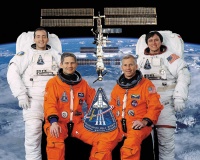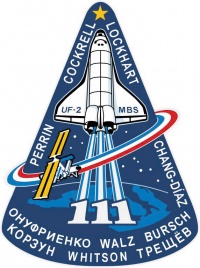STS-111
From The Space Library
 | |
| Organization | NASA-Office of Space Flight (United States) |
|---|---|
| Mission type | Human Crew,Resupply/Refurbishment/Repair |
| Launch date | June 5, 2002 |
| Launch vehicle | Space Shuttle |
| Launch site | Cape Canaveral, United States |
| COSPAR ID | 2002-028A |
| Inclination | 51.6 degrees |
| Experiments | Here |
| Alternate Names | 27440 |
| Additional Information | Here |
| Data Collection | Here |
| Payload Mass Up | 13521.58 kg |
| Payload Mass Down | 10045 kg |
| Orbiter | Endeavour |
| Lift Off Mass | 2,053,745.00 kg |
| Orbiter Weight at Liftoff | 116,765.45 kg |
| Orbiter Weight at Landing | 99,592.27 kg |
| Landed | Concrete runway 22 at Edwards Air Force Base, Calif. |
| Orbits of Earth | 217 |
| Orbital Altitude | Approximately 240 nautical miles |
Contents |
[edit] Crew
- Commander: Kenneth D. Cockrell
- Pilot: Paul S. Lockhart
- Payload Commander:
- Mission Specialist 1: Franklin R. Chang-Diaz
- Mission Specialist 2: Philippe Perrin, Centre National D'Etudes Spatiales (CNES, French Space Agency)
- Mission Specialist 3:
- Mission Specialist 4:
- Mission Specialist 5:
- Payload Specialist 1:
- Payload Specialist 2:
ISS/Mir Crew Transport
[edit] Mission
STS 111 is an American shuttle spacecraft that was launched from Cape Canaveral at 21:23 UT on 5 June 2002. It carried a crew of seven astronauts (four American, two Russian and a French) and material to the International Space Station (ISS). Three of the astronauts (one american and two Russians) will remain on ISS for four months, relieving its earlier crew of three. The crew repaired a malfunctioning gyroscope and installed debris sheilds on the Zvesda module. They repaired the wrist joints on the canadian robotic arm/crane, and also facilitated its (eventual) full mobility across the full length of the ISS. The shuttle returned on 19 June 2002 to Edwards AFB in California with four of its crew, plus the three astronauts who had stayed on the ISS for over six months.
[edit] EVA
Extravehicular Activity (EVA) conducted by Franklin Chang-Diaz and Philippe Perrin during three space-walks for a total of 19 hours, 31 minutes. EVA 1, 7 hours, 14 minutes; Chang-Diaz and Perrin attached a power and data grapple fixture onto the P6 truss, setting the stage for the future relocation of the P6, and removed thermal blankets to prepare MBS for installation. Whitson and Walz used Canadarm2 to lift the MBS out of the payload bay. EVA 2, 5 hours, 0 minute; the focus was on outfitting and permanently attaching the MBS to the MT. Chang-Diaz and Perrin attached power, data, and video cables from the station to the MBS. EVA 3, 7 hours, 17 minutes; Chang-Diaz and Perrin replaced Canadarm2's wrist roll joint.
[edit] Payload
ISS Utilization Flight UF-2; Leonardo Multi-Purpose Logistics Module carrying experiment racks, equipment, and supplies; Mobile Base System (MBS) installed on Mobile Transporter (MT) to complete Mobile Servicing System; replacement of Canadarm2 wrist roll joint; and fourth ISS crew exchange. ISS crew members Walz and Bursch set new record for longest U.S. space flight (196 days), breaking the previous record of 188 days in space held by Shannon Lucid aboard the Russian space station Mir.
[edit] Books about the Space Shuttle Program
Buy This Book Click here |
Buy This Book here |
Buy This Book Click here |
Buy This Book Click here |





